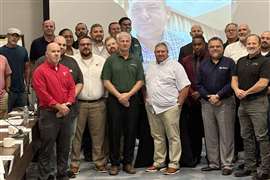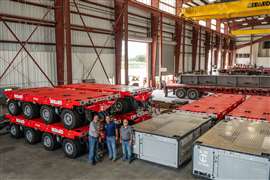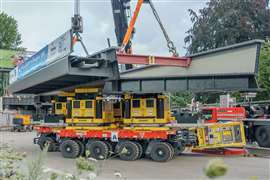Read this article in French German Italian Portuguese Spanish
The key to safe sling selection
16 May 2024
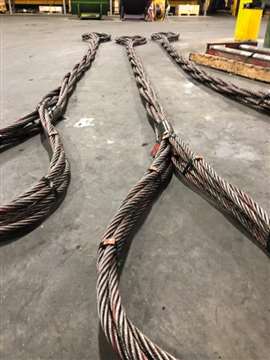 Wire rope multi-part slings
Wire rope multi-part slings
I have always been told that every job is easy if you have the right tools. The same philosophy is true for lifting slings and rigging. Choosing the proper sling before making a lift will ensure the task is performed correctly and most importantly, safely. Understanding the basics of selecting a sling for your lifting operations is vital for your efficiency and productivity. The rated capacity of a sling varies depending upon the sling material, the size of the sling, and the type of hitch. Wire rope, alloy steel chain, synthetic web, synthetic round and natural and synthetic fiber slings all have unique properties that need to be evaluated before the material selection can be made. Each type of sling has its advantages and disadvantages.
There are four primary factors to take into consideration when selecting a sling to lift a load. They are: (1) the physical parameters of the load; (2) the number of legs and the angle they make with the horizontal; (3) the rated capacity of the sling; and (4) the condition of the sling.
1. Physical parameters of the load
The size of the object to be lifted, and particularly the location of lifting points, will affect sling selection. The weight of the lift, while a critical component, is only a part of the information. The location of the center of gravity is also necessary to determine sling loadings. If the load has small diameter corners, protective blocking or “softeners” must be used so that sling capacity isn’t reduced. Also, if lifting a painted object or an object with a finished surface, padding or softeners may be needed between the sling and the load to protect the load.
2. Number of legs and angle with the horizontal
As the angle formed by the sling leg and the horizontal decreases, the rated capacity of the sling also decreases. In other words, the smaller the angle between the sling leg and the horizontal, the greater the load on the sling leg. The minimum angle allowed is 30 degrees.
3. Rated capacity
The rated capacity of a sling must never be exceeded. The rated capacity is based both on sling fabrication components (minimum breaking force of component material used, splicing efficiency, number of component parts in sling and number of sling legs) and sling application components (angle of legs, type of hitch, D/d ratios, etc.). If you are using one sling in a vertical hitch, you can utilize the full rated lifting capacity of the sling, but you must not exceed that lifting capacity. Under no circumstances shall a sling’s rated capacity be exceeded.
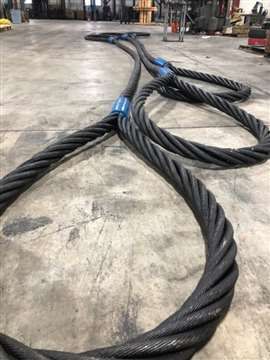 Wire rope single leg sling
Wire rope single leg sling
The American Society of Mechanical Engineers (ASME) B30.9 requires that all slings be tagged with the rated capacity, name or trademark of the manufacturer and the diameter or size of the sling. Specific sling types require other information the user should be informed about. The user shall maintain this identification so that it is legible during the life of the sling. All persons using the sling should read the tag and understand the information on it.
4. Condition of sling
A visual inspection of all lifting slings is required at each shift before the sling is used. Slings used in severe or special service should be inspected before each use. If the sling does not pass inspection do not use it.
Wire rope
Wire ropes are the most common type of lift slings in the construction industry today. Wire rope is often used in slings because of its strength, durability, abrasion resistance and ability to conform to the shape of the loads on which it is used. In addition, wire rope slings are able to lift hot materials. Wire rope with IWRC’s are significantly more common today due to increased strength with resistance to crushing damage and increased heat resistance. Wire ropes are manufactured and tested in accordance with ASTM A1023 guidelines. If other grades of wire rope are used, use them in accordance with the manufacturer’s recommendations and guidance. Only regular lay wire rope shall be used for fabricating lifting slings.
The rated capacities for wire rope slings are based on a design factor of 5 per ASME B30.9. The design factor and other factors are used to calculate the rated capacities.
Follow the recommendations of the sling manufacturer when you use wire rope slings at extreme temperatures. Chemically active environments can affect the strength of wire rope slings. Consult the manufacturer before using a sling in such environments.
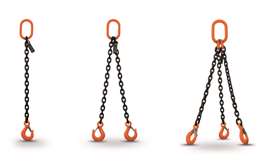 Alloy steel chain sling configurations
Alloy steel chain sling configurations
Alloy steel
Alloy steel chains offer maximum toughness and are often used for their strength, durability and ability to conform to the shape of the loads on which they are used. In addition, these slings are able to work in high temperature applications. Alloy steel chain slings are made from various grades of alloy, but the most common grades in use are grades 80 and 100. The most appealing trait is their ability to be repaired, tested and re-certified for future work.
The rated capacities for Alloy Steel Chain slings are based on a design factor of 4 per ASME B30.9. The design factor and other factors are used to calculate the rated capacities. Each high strength alloy chain sling must be marked with an individual sling identification.
Alloy chain slings can provide lifting service in elevated temperatures. The sling user must reduce the load rating based on the temperature the sling is working at. The strength of alloy steel chain slings can be affected by chemically active environments therefore consult the manufacturer before the sling is to be used in chemically active environments.
Synthetic web
Synthetic web slings are widely used slings and offer a number of advantages for rigging purposes. The most commonly used synthetic web slings are made of nylon- or polyester-type yarns. They provide High Strength to weight ratio, convenience, availability, load protection, and by far they are the lowest cost. Synthetic web slings will wrap tightly around loads and provide good surface contact.
Synthetic webbing materials other than nylon and polyester are also used and the manufacturer should be consulted for specific data for proper use. Review of the lifting plan and application should be performed before using in and around chemical environments. Protection of the sling is required for all lifts to ensure damage to the sling does not occur during lifting operations.
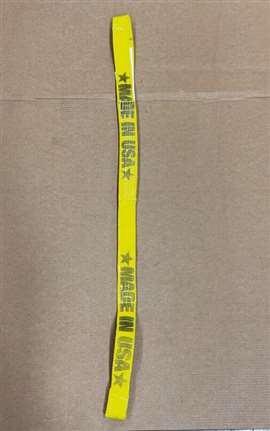 Synthetic web sling eye-eye sling
Synthetic web sling eye-eye sling
The rated capacities for Synthetic Web slings are based on a design factor of 5 per ASME B30.9. The design factor and other factors are used to calculate the rated capacities.
Inspection of Synthetic Web slings is critical as they are more subjective to cuts and abrasion. Regular inspection of the slings before is critical to ensure the safe usage and performance of the sling. If any damage or deterioration is present, remove the sling or attachment from service immediately.
Synthetic Web slings must be stored in an area where they will not be subjected to mechanical, chemical, ultraviolet damage, or to extreme temperatures. When slings are exposed to extreme temperatures, follow the guidance provided by the sling manufacturer or qualified person. Consult the sling manufacturer for recommended inspection procedures when nylon or polyester webbing slings are extensively exposed to sunlight or ultraviolet light.
Synthetic round
Synthetic round slings offer a number of advantages for rigging purposes. They provide improved strength, ease of use, load protection and economy. Synthetic round slings will conform to the shape of the load, therefore protection of the sling is required for all lifts to ensure damage does not occur during lifting operations.
Each synthetic material has its own unique properties. Certain synthetic materials perform better than others in specific applications and environments. Some round slings are manufactured using high performance materials, but most are made of nylon- or polyester-type yarns.
The rated capacities for Synthetic Round slings are based on a design factor of 5 per ASME B30.9. The design factor and other factors are used to calculate the rated capacities.
Synthetic Round slings provide a woven jacket over the load bearing fibers. The jacket’s intent is to protect the fiber from abrasion, contaminants, and UV degradation. Items to look for in the jacket are holes, tears, cuts, abrasive wear, or snags, that expose the core yarn. Make a thorough inspection of slings and attachments. Where any such damage or deterioration is present, remove the sling or attachment from service immediately.
Long-term exposure to heat, sunlight or ultraviolet radiation can affect the strength of polyester round slings. Chemically active environments can affect the strength of synthetic round slings. Consult the manufacturer before using a sling in such environments. Ensure that in chemically active environments the cover is the same yarn as the load-bearing core. Review of the lifting plan and application should be performed before using in and around chemical environments.
Natural and synthetic
Natural and synthetic fiber rope slings are becoming much more popular and have been used in marine operations for years. Fiber rope slings are pliant, grip loads well, and do not mar the surface of the load. The most common constructions for fiber rope slings are 3-strand laid, 8-strand plaited, and hollow braided nylon and polyester. High performance HMPE and Aramid fibers are becoming more popular and are used to provide additional strength to the rope.
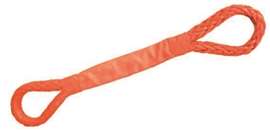 Synthetic rope sling
Synthetic rope sling
The rated capacities for Fiber Rope slings are based on a design factor of 5 per ASME B30.9. The design factor and other factors are used to calculate the rated capacities.
One of the major benefits of Synthetic Fiber rope slings is that it is approximately 1/8 the weight of steel for a given diameter. The ropes are designed to absorb shock and are flexible for ease of handling. They are resistant to crushing, bending fatigue, and distortion.
Be sure to consult the sling manufacturer for long-term heat exposure. Long-term exposure to sunlight or ultraviolet radiation can affect the strength of natural, nylon and polyester rope slings. Review of the lifting plan and application should be performed before using in and around chemical environments.
Most important tool
When it comes to using lifting slings and assemblies, knowledge is your most important tool. We know this guide can’t answer every question you have about lifting slings, but the intent is to provide some basic advantages of different products. The pros and cons of each material must be reviewed before the lift is made. If you have more informational needs discuss these with your sling manufacturer or a qualified expert.

THE AUTHOR
For the past 24 years Timothy W. Klein has worked in the Fabricated Products Division at WireCo. He is currently the director of structures and fabrication. He is a licensed professional engineer in the several U.S. states, as well as holding a professional engineering license in Canada.
STAY CONNECTED


Receive the information you need when you need it through our world-leading magazines, newsletters and daily briefings.
CONNECT WITH THE TEAM










